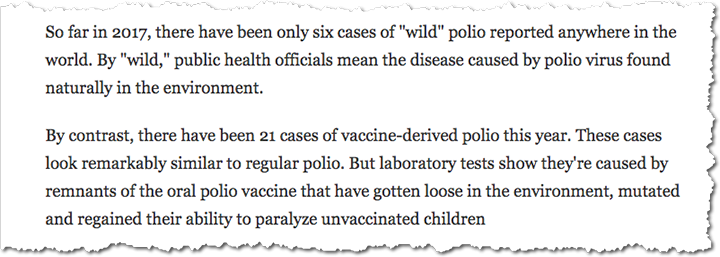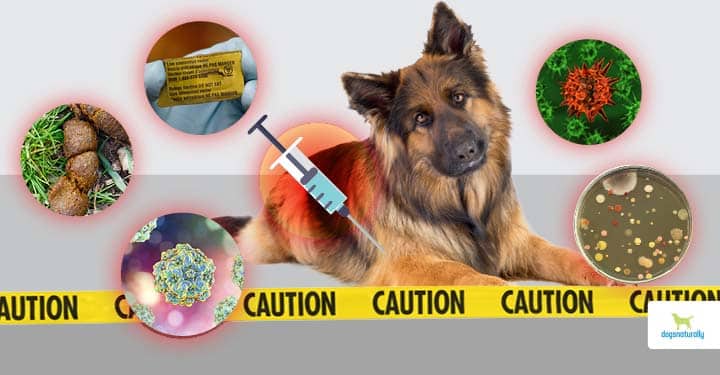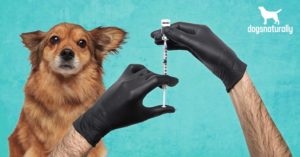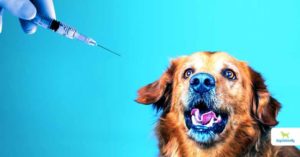Vaccination comes with a lot of unintended consequences … even more than you might have thought of.
You can read a lot of articles on this site about the risks and possible adverse effects of vaccinating your dog … from autoimmune disease or cancers to seizures, thyroid disease, allergies, digestive issues and even death.
But there are other dog vaccine dangers that may surprise you.
These may not be the risks you commonly consider when you make vaccination decisions for your dog … but they’re an important factor in understanding the hazards of vaccination … and they can affect your dog!
So read on to learn about our top 5 unexpected vaccine dangers that can increase the risks of vaccinating your dog.
#1 Rabies Baits Bite Back
The governments of the US and Canada drop rabies baits across rural areas in both countries in an effort to prevent rabies in wildlife. These ORV (oral rabies vaccine) baits are coated with fishmeal to entice animals to eat them, and packaged in little cubes or sachets. They’re dropped from planes and helicopters every year.
You may think this is a good idea as nobody wants rabid wildlife hanging around their neighborhood. But there are risks with these baits. The USDA (US Department of Agriculture) claims they’re “safe for more than 60 different species of animals, including domestic dogs and cats.” They say that if your dog eats a lot of the baits, he might get an upset stomach but “no long-term health risks.“
But can that really be true? Here’s the problem.
The vaccines in the baits are recombinant vaccinia-rabies glycoprotein. Recombinant means two viruses are spliced together. So, in addition to the rabies virus, these baits also carry vaccinia, the immunizing agent used in smallpox vaccines. This combination of two viruses is a genetically modified vaccine and it can create some risks.
The main risk is that oral rabies baits contain live virus vaccines. In theory, recombining the live virus with the smallpox virus creates a weakened strain of rabies and doesn’t allow true infection. If the animal who eats the bait is healthy, his body should form an immune response to the vaccine and he’s vaccinated against rabies.
But if the animal is in a weakened state when he eats the bait, it’s quite likely that either the vaccine will fail, or it will create the disease it was intended to protect against … yes, rabies. And to make matters worse, the genetically engineered virus can jump species and can be spread by aerosolization … meaning no bite is needed for one of these infected animals to spread the disease.
#2 Virus Shedding Is Virus Sharing
Many vaccines given to dogs are modified live virus (MLV) vaccines. MLV vaccines are used because they stimulate cell-mediated immunity better than killed viruses. Examples are distemper, adeovirus-2 (hepatitis, canine respiratory virus), parvovirus, intranasal bordetella, intranasal coronavirus and parainfluenza.
These vaccines can be shed in feces and urine for weeks after vaccination. Studies on dogs vaccinated with CPV-2 parvovirus show that the virus can remain in the blood stream and be shed via feces for as long as three to four weeks after vaccination.
This means these diseases can be spread through vaccination. Think about the dog who gets a bordetella shot a few days before going to stay at a boarding kennel. He’ll be shedding the disease for up to 7 weeks after vaccination … exposing every other dog at the facility to kennel cough.
The other problem is that MLV vaccines can make your dog ill. When MLV vaccines are given to animals with compromised immune systems they can cause a weakened form of the virus they’re supposed to protect against. Even the American Animal Hospital Association (AAHA) admits this, stating, “Since it is a truly live virus of a disease that we are trying to prevent, there is a small risk that the inactive virus can revert into the true form of the virus.”
Holistic veterinarian Patricia Jordan DVM explains that the leptospira organism can become a source of infection for humans in contact with a dog vaccinated for leptospirosis. Dr Jordan has personally witnessed several cases in which she had no doubt that a leptospirosis vaccine was the cause of subclinical infection in a dog and therefore could be transmitted to a human.
Dr Jordan says: “Leptospira can and will shed in a vaccinated dog and in turn, infect any humans living in the same household!”
When a duck hunter contracted leptospirosis in California, the state’s field study didn’t find any leptospira in the bodies of water he frequented. This strongly suggests that the man became infected through transmission of the leptospira from his vaccinated dog.
#3 Retroviruses Can Be Deadly
Retroviruses in vaccines can have lethal effects. Retroviruses occur because viruses in vaccines are grown on living tissue, and they’re often from other species. That’s how monkey viruses (like SV-40 in polio vaccines, described below) are passed on to humans through vaccination. Dogs are also exposed to retroviruses through their vaccines.
Canine parvovirus suddenly appeared around the world in 1978 and is now widely considered to have come from the feline panleukopenia virus (FPV). At some point, the distemper vaccine was grown on cat kidney cells … from cats infected with FPV. The distemper vaccine was injected into dogs and the numbers of parvovirus cases began to explode.
Holistic veterinarian Deva Khalsa VMD explains how she witnessed this when she was at veterinary school …
“When I entered veterinary school in 1976, parvovirus disease in dogs didn’t exist. There were no parvovirus cases at the University of Pennsylvania School of Veterinary Medicine until 1978.”
That’s when Dr Khalsa observed case after case of canines with life-threatening, bloody diarrhea admitted into ICU to be placed under 24 hour care on supportive IV fluids.”Parvo type 2 virus appeared simultaneously around the world and killed hundreds of millions of dogs in Australia, Europe, Asia and the US. At the time of the outbreak, this brand spanking new disease didn’t seem to be spreading from one dog to another. World health professionals wondered how the disease could be traveling around the world so quickly. They found their answer: in vaccines.”
The new disease was being delivered to dogs in their regular booster shots. Batches of vaccines had been shipped to veterinarians all over the world. In those days the booster shot would have been for distemper, hepatitis, leptospirosis and parainfluenza, with no parvovirus; there was no such thing as DHLPP.
In 2010, researchers in Scotland and Japan isolated a feline retrovirus in both dog and cat vaccines. (Isolation of an Infectious Endogenous Retrovirus in a Proportion of Live Attenuated Vaccines for Pets, Journal of Virology, April 2010, p. 3690-3694, Vol. 84, No. 7.)
The authors stated …
Collectively, our data show unequivocally that RD-114 is present in live attenuated vaccines commonly used in dogs and cats from different continents and produced by three different manufacturers […] the large-scale exposure to RD-114, particularly of the dog population, may have effects that are impossible to predict even if successful RD-114 transmission was an extremely rare event.
In US Dog World in March 1995, Dr Jean Dodds discussed the implication of retrovirus contamination in dog vaccines…
“Immune-suppressant viruses of the retrovirus and parvovirus classes have recently been implicated as causes of bone marrow failure, immune-mediated blood diseases, hematologic malignancies (lymphoma and leukemia), dysregulation of humoral and cell-mediated immunity, organ failure (liver, kidney) and autoimmune endocrine disorders – especially of the thyroid gland (thyroiditis), adrenal gland (Addison’s disease) and pancreas (diabetes).”
The case of the SV-40 monkey virus being found in polio vaccines is well known … experts determined that between 1954 and 1963, more than 100 million people worldwide were exposed to SV-40 through vaccination. SV-40 has been found in brain tumors, bone cancers, lung cancers and leukemia.
#4 Virus Mutation Spreads Disease
Viruses can mutate, allowing them to spread more easily. One example is the CPV-2 canine parvovirus, the most common form of parvo seen in dogs.
Dr Patricia Jordan explains…
“There are two canine parvoviruses: canine parvovirus-1 and canine parvovirus-2. CPV-2 is the primary cause of the puppy enteritis that we commonly see. Over the years, parvo has mutated from CPV-2 to CPV-2b to CPV-2c. It seems that dogs may be getting the ultimate revenge on cats: the CPV-2c strain of parvovirus is now crossing species and infecting cats with another brand new virus.”
This happens with human viruses too. Polio is a case in point … in Nigeria, the polio vaccine is mutating and the World Health Organization blames unvaccinated children. The WHO claims that the virus in the water supplies (passed by vaccinated children) is supposedly safe but is picked up and mutated by unvaccinated children, becoming a new virulent strain that is infecting both vaccinated and unvaccinated children.
National Public Radio has published a story about this phenomenon … Mutant Strains Of Polio Vaccine Now Cause More Paralysis Than Wild Polio.

A virologist with the CDC (Centers for Disease Control and Prevention), Olen Kew, says that there’s no difference in virulence between wild polio viruses and the mutated form. “The only difference is that this virus was originally in a vaccine vial.” This means that as long as children are vaccinated for polio in Nigeria, the polio virus will remain in the environment.
A similar thing happens with the bird flu virus. Research by Indonesian virologist Chairul Anwar Nidom shows that that mass inoculations of birds contribute to genetic mutations that increase the virulence and severity of the virus. Veterinary pathologist Dr R Wasito has noted that vaccination for the bird flu has allowed it to mutate and that other animals including dogs, cats, raccoons and flies can now carry the mutated virus.
#5 Vaccines Are Unpredictable
One problem with vaccine manufacturers’ claims of efficacy of their products is that vaccinated populations don’t live in a sterile lab where their testing is done.
In the research lab, vaccines appear to be very effective. Unvaccinated puppies die of parvo in research labs while vaccinated puppies live.
In the field, vaccines are much less predictable. Dr Michael Fox offers some illustrations of what can happen in the field.
“Wildlife biologist Dr Roger Burrows noted that lions in Serengeti National Park (SNP), followed by those in the Masai Mara of Kenya, died like flies in 1994 from a new strain of canine distemper.”
It turned out that the same strain of distemper found in the lions was also in experimental vaccines on dogs in the area during a rabies vaccination trial. The same strain was also found to have caused the death of most of a captive colony of wild dogs in Mkomzai Game Reserve in Tanzania in 2000-2001. The wild dogs had been vaccinated against distemper using an inactivated strain developed for North Sea seals.
Dr Burrows further explains that in 2007, the same new distemper strain was again identified in free-living African wild dogs in Masai areas east of SNP. This area was conducting mass vaccinations of local domestic dogs against distemper, parvovirus and rabies. The outbreak in one large wild dog pack caused high death rates among this highly endangered species.
The fact that local breeds of domestic dogs around SNP and the Masai Mara were vaccinated against rabies, and then soon after succumbed to a virulent outbreak of distemper, suggests that the rabies vaccinations caused immunosuppression, creating increased susceptibility to distemper.
Dr Vernon Coleman MB described how, in 1989, hyenas were threatened with extinction when scientists vaccinated individual animals to protect them against rabies … but more than a dozen packs then died of rabies within a year. This happened even in areas where rabies had never been seen before. When researchers tried using a non-infectious form of the pathogen (to prevent the deaths of the remaining animals) all members of seven packs of dogs disappeared.
Dr Coleman suggests…
And yet the rabies vaccine is now compulsory in many parts of the world. Is it not possible that it is the vaccine which is keeping this disease alive?
All of these 5 dangers highlight the risks you take when you vaccinate your dog. Think carefully and do your research before you vaccinate!
If you do vaccinate your dog, watch for any adverse reactions … even chronic illness that can appear weeks or months down the road may stem from your dog’s vaccinations.
Then take steps to treat them …
Vaccine side effects can often be treated successfully by a homeopathic veterinarian. Find one at theavh.org (many will do phone consults so they don’t have to be local). A good soil-based probiotic can support your dog’s detoxification of heavy metals and other contaminants.














